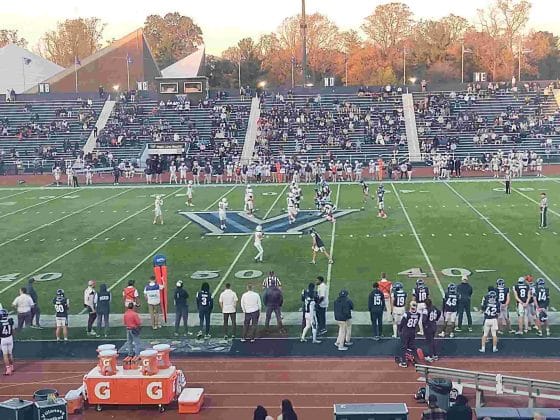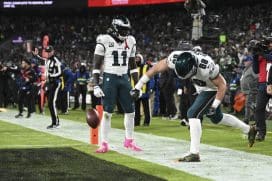Eagles
Philadelphia Eagles: 2020 Offensive Predictions
By Stone Loitfellner, Sports Talk Philly Contributing Writer
Believe it or not, the season is just around the corner, lurking, only days away. Although Philadelphians and close-by Eagles fans may not be able to assemble together in the beloved Linc, we’ll all be watching with anticipation. Waiting for the first kick of that football to officially start the Birds’ season. However, even though the season is oh so close it isn’t quite here yet. To make up for some of that time we’ll go over some offensive predictions for this upcoming season.
Zach Ertz – TE – 2019 stats: 15 games, 88 receptions, 916 yards, 10.4 Y/R, 6 TDs
2020 Projections: 16 games, 91 receptions, 964 yards, 10.6 Y/R, 7 TDs
Why:
Zach Ertz was Carson Wentz‘s main target last season, partially due to Ertz’s talent, partially due to the absence of true receiving production from the wideouts. Not only did Ertz lead the team with 88 catches and 916 yards, he finished the season with 30 more catches than the runner-up, fellow tight end Dallas Goedert, and 45 more than the leading wide receiver, Alshon Jeffery. The yardage situation tells a similar story with Ertz once again in the lead by a wide margin, 309 more yards than Goedert, who once again found himself second in the rankings. Then there’s Alshon, the leading wide receiver with just 490 yards.
Now, one thing the Eagles made sure to do this off-season was adding receiving help. They made a move to land Marquise Goodwin who unfortunately but understandably decided to sit out this season. However, they did spend quite a lot of draft capital in receivers by using their first pick on Jalen Reagor (who suffered an unfortunate injury in training camp forcing him to miss the season opener and possibly the following game). They also picked John Hightower in the fifth and Quez Watkins in the sixth. Although the two of them are late-round picks, chitter-chatter from training camp and early assumptions have one if not both getting some playing time this season.
Meanwhile, DeSean Jackson is back after playing in just three games last year, a much needed deep threat. There’s also the standout from last year that shouldn’t be forgotten, Greg Ward Jr., especially with Alshon Jeffery currently out on the PUP list. Leaving the Eagles early week(s) projected depth chart to look like this: WR1 Desean Jackson, WR2 JJ Arcega-Whiteside (who we’ll talk about shortly) and in the slot, Greg Ward Jr. This once again leaves a very reliable security blanket in Zach Ertz but, unlike last year, there’s more for the opposing defense to pay attention to. DeSean’s speed alone commands the safeties to respect his game and play back, which can open Ertz up for check-downs or plays in the middle of the field. Then there’s Greg Ward in the slot, who is reportedly the favorite target in camp and was Wentz’s favorite receiver down the stretch last year. After getting some real NFL snaps under his belt, Greg Ward Jr. should only improve this year, in turn making defenses respect him more which, hopefully, will open up Ertz more. With the same being able to be applied to Dallas Goedert’s effect on Ertz.
DeSean Jackson – WR – 2019 stats: 3 games 9 receptions, 159 yards, 17.7 Y/R, 2 TDs
2020 Projections: 12 games 50 receptions, 870 yards, 17.4 Y/R, 5 TDs
16 games 66 receptions, 1,160 yards, 17.5 Y/R, 8 TDs
Why:
It’s no argument that the Eagles’ offense looks very different and way more explosive when DeSean is playing. His ability to stretch the field paired with his “getaway” speed would improve any offense really but when you give him a quarterback like Carson Wentz, magical things can happen. Although DeSean is getting older entering the season at 33 years old, in 2018 just two seasons ago with Washington he put up 774 yards in 12 games while posting a 18.9 Y/R, making a 17.4/.5 projection inside the realm of possibility. Of course like previously mentioned with Zach Ertz, DeSean’s deep threat doesn’t always mean he gets the ball. Him going deep can easily provide opportunities around the offense opening up, Ertz, Ward, Arcega-Whiteside, and/or Goedert.
Now somewhat due to his age but mostly due to the team’s offensive options I do have DeSean’s average yards per reception being 1.4 lower. To keep Jackson healthy it would make sense to not run him as deep as often as a coach would or could in the past when he was younger. Of course, this doesn’t mean Jackson is no longer a threat, while defenses are going through their match-ups leaving DeSean singled up at any moment in the game can create an instant spark and big play for the Eagles. Expect some short routes like slants and drags breaking open after DeSean gets the ball and goes but also expect those big deep plays that end up in the endzone for six that we all knew and loved to come back again this season.
Greg Ward Jr. – WR – 2019 stats: 7 games 28 receptions, 254 yards, 9.1 Y/R, 1 TD
2020 Projections: 16 games 66 receptions, 620 yards, 9.3 Y/R, 4 TDs
Why:
This may be my boldest take but it’s the hill I’m willing to die on more than any player except for the possibility of Miles Sanders who I expect big things from this season. For now, though the main focus is on Greg Ward Jr. who like previously stated was the leading receiver down the stretch last year and maintained that role during camp this pre-season. Before going deeper into the reason why Greg Ward Jr. will have a big season this year keep in mind last year even though he played in seven games he only started in three.
If any further proof is needed that Greg Ward Jr. was the main target for Wentz last season seeing less than five targets in just one of his seven games while getting nine and seven targets in two games each. Ward Jr’s catch percentage was also quite impressive last season dipping under 75% just twice. Now once again with DeSean Jackson’s speed, Zach Ertz’s consistency at a starting level, and even Dallas Goedert’s still growing development, Greg Ward Jr. can easily be forgotten by opposing defenses, and with him lined up in the slot it shouldn’t take Wentz long to find him and keep it up for 16 games.
Jalen Reagor – WR – 2019 NCAA stats: 43 receptions, 611 yards, 14.2 Y/R, 5 TDs
2020 Projections: 14 games, 43 receptions, 525 yards, 12.2 Y/R, 3 TDs
Why:
Unfortunately, the Eagles first-round pick suffered a shoulder injury during practice forcing him to miss game one and most likely game two. Being a first-round pick gave him early expectations but don’t expect too much from the first-year player. After coming back from injury, Reagor may not be thrust into the immediate spotlight but could easily find himself starting on the outside opposite of DeSean while Ward Jr. remains in the slot. Still, expect serviceable numbers from the TCU product. In college, Reagor dealt with some quarterback struggles but was still able to put up 611 yards with 14.2 yards per reception. However, in his 14 games as an NFL player, I don’t expect him to put up the same or better numbers. Instead I see him taking just a slight step back, to no fault of his own.
Even as a first-round pick, when Reagor joins back up with the team he’ll have to fight for some of his targets with DeSean and Ertz above him on the priority list, possibly being behind Greg Ward Jr., as well. Not to mention Miles Sanders’ running production and ability to catch out of the backfield taking targets away from all previously mentioned players (which isn’t necessarily a bad thing). Although Reagor may not give immediate impact with big numbers, I expect an exponential growth rate from the first-rounder, with his best games arriving during the back half of the season.
J.J. Arcega-Whiteside – WR – 2019 stats: 10 receptions, 169 yards, 16.9 Y/R, 1 TD
2020 Projections: 24 receptions, 319 yards, 13.3 Y/R, 4 TDs
Why:
I know it’s quite the drop-off from everyone else on the list but it’s still a step up from Arcega-Whiteside’s rookie performance, which frankly left little room for a sophomore slump but plenty of room for growth. I definitely don’t think Arcega-Whiteside will maintain a 16.9 Y/R over 16 games, especially since that would put him second on the team just behind DeSean Jackson, but I do think he provides enough of a deep threat to give the Eagles a 13.3 Y/R. Arcega-Whiteside’s body type and play style should also provide the Eagles with another red-zone target and, with a season under his belt, he should understand how to read defenses more and where to set himself up for a couple of touchdowns.
Although I don’t expect as much from J.J. Arcega-Whiteside, it’s not much fault of his own. In his first two seasons, he’s already worked with two different receiving coaches. Still, while defenses are moving back for DeSean, linebackers are focused on the dual-threat of tight ends the Eagles have and Greg Ward Jr. getting a respectable amount of snaps and targets, J.J. Arcega-Whiteside should be left mostly on an island, giving him the opportunity to prove he’s improved and shouldn’t be written off after last season’s lackluster performance.
Dallas Goedert – TE – 2019 stats: 58 receptions, 607 yards, 10.5 Y/R, 5 TDs
2020 Projections: 62 receptions, 644 yards, 10.4 Y/R, 5 TDs
Why:
Dallas Goedert is heading into his third season and has shown improvement in his first two seasons, leaving no surprise to expect even more improvement from the tight end in 2020. I know only four more receptions and 37 more yards doesn’t seem like much, but for a back up tight end, it’s nothing to scoff at. Especially when the starting tight end is on the level Zach Ertz is at, Goedert, in theory, shouldn’t even be seeing 600 yards when compared to the likes of Travis Kelce’s and George Kittle’s backups, who put up 158 yards combined.
Like I’ve repeated, defenses facing the Eagles will most likely be keeping their safties back to protect against the deep pass, which is good news for any receiver in the slot and tight ends who should find plenty of room in the middle of the field. Since the Eagles have receivers that should be able to stretch the field better than last season, Goedert (and Ertz) likely won’t be asked to go down the field as much but instead, play a check down role in the middle, making Goedert’s projected yards per reception slightly less than last year. Still, with defenses distracted, Goedert should see very similar numbers to last year with a step in the right direction showing some improvement.
Miles Sanders – RB – 2019 stats: 179 carries, 818 yards, 4.6 Y/A, 3 TDs, 50 receptions, 509 yards, 10.2 Y/R, 3 TDs
2020 Projections: 222 carries, 1,065 yards, 4.8 Y/A, 6 TDs, 76 receptions, 706 yards, 9.3 Y/R, 4 TDs
Why:
Miles Sanders was the Eagles 2019 2nd round pick, a highly coveted one with high expectations. However, Sanders was one half of a split backfield last season with Jordan Howard taking the starting reigns. Yet, Sanders was still able to produce and, when Jordan Howard went down, Sanders stepped up and filled the role without missing a beat. Now Jordan Howard is in Miami, leaving the workload for Sanders to take, making his second season his first true test. He’s due to be a 3-down, bell-cow back, confirmed by running back coach Duce Staley.
With Jordan Howard gone, that technically leaves 119 touches unaccounted for. Obviously not every last touch will go to Miles Sanders, but a good chunk of those touches will find their way to Sanders. If you take Howard’s and Sanders’ rushing attempts from last season, you get 298. As you can see, I have Sanders running the ball 222 times and leaving 76 carries. Those could be divvied up to Corey Clement and Boston Scott, but shouldn’t be looked into too much.
What should get attention is the fact that Sanders is poised for an excellent sophomore campaign. An all-around back that can run in or outside of the tackles and catch the ball out of the backfield giving the Eagles the running back they’ve been looking for since LeSean McCoy was traded. They say production is talent and opportunity combined and Sanders certainly has the talent with the opportunity laying in front of him. Sanders, with one season under his belt and an extended workload, should find quite the improvement for the second-year back. Sanders himself has stated he wants to be more versatile and this season is his first chance to put his money where his mouth is. No one should be surprised if he does.
Carson Wentz – QB – 2019 stats: 388 completions, 607 attempts, 63.9 completion percentage, 4,039 yards, 27 TDs, 7 Int, 62 rushes, 243 yards, 3.9 Y/A, 1 TD, 16 fumbles
2020 Projections: 450 completions, 642 attempts, 70 completion percentage, 4,995 yards, 35 TDs, 8 Int, 54 rushes, 226 yards, 4.2 Y/A, 1 TD, 10 fumbles
Why:
450 completions and 642 attempts may be eyebrow-raising numbers since it would be two career highs for Wentz, but 2020 may be one of the most complete rosters Wentz has played with since entering the league in 2016. Not to mention he gets his deep threat, DeSean Jackson, for (hopefully) 16 games or any amount of games longer than the three last year where they showed flashes of what the two can do together. Meanwhile, Ertz, Goedert and Greg Ward Jr. should be enough for Wentz to move the ball up and down the field. Also, remember Miles Sanders wants to be more like Christian McCaffrey, meaning more targets in the passing game, giving Doug Pederson reasons to throw the ball more.
The moves made in the offseason, including the draft, should bring the Eagles offense a few steps forward compared to last year. Once again, DeSean’s skillset allows Wentz to throw deep while there’s plenty of options for checkdowns or simply some safer throws. However, I do have Wentz throwing a career-high eight interceptions due to a simple equation: more deep passes tend to equal more interceptions. If Wentz is airing it out more than previous years, one extra interception isn’t much concern.
As far as Wentz’s rushing, I expect fewer attempts from last season since there’s more help for Wentz in the passing game. Due to this, I think Wentz’s average yards per attempt will slightly increase since the defense shouldn’t be crowded at the line of scrimmage or spending too much time within five yards of the l.o.s., instead going deeper down the field to cover receivers, tight ends or even running backs. As far as the fumbles go, Wentz had a concerning career-high of 16 last season. I expect him to tighten up work on his awareness and mechanics to keep the ball a little more secure this year for a still too-high 10 fumbles. This seems to be his main weakness and hopefully something he’ll quickly learn to fix as his career continues.
Main Concerns: Offensive-Line
Many fans already know about Philadelphia’s apparent injury bug, and it struck again this pre-season during training camp. It first started with all-pro guard Brandon Brooks tearing his Achilles leaving him sidelined for the entirety of the 2020 season. Meanwhile, 2019’s first-round pick left tackle Andre Dillard suffered a bicep injury, leaving him out for the entire season (2020 would’ve been his first year as a full-time starter). Although the Eagles signed Jason Peters this year they brought him in to play guard but contract difficulties are causing a hiccup with moving him to his old position of left tackle. This has forced the Eagles to shuffle up the line a bit, placing lifetime guard Matt Pryor at left tackle, who reportedly hasn’t adjusted well. Hopefully, the offensive line can be figured out by week one.












































